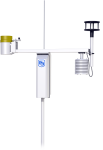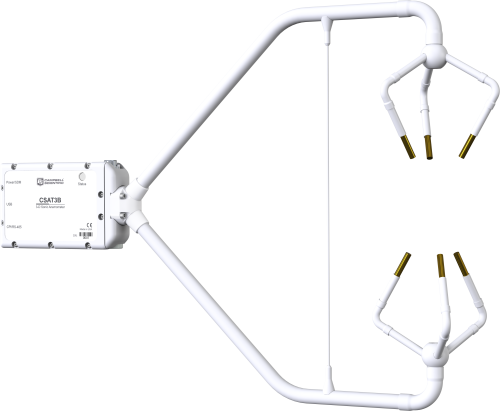Was wir tun
From single research weather stations to mesoscale weather networks (mesonets), Campbell Scientific automatic weather stations have become the worldwide standard for climate and boundary-layer meteorology. They are integral parts of forecasting and monitoring systems worldwide. Accurate measurements, low power requirements, and proven reliability in extreme weather conditions make our weather stations ideal for all types of meteorological and climatological monitoring anywhere on earth.
Mehr erfahrenFor an introduction to our solutions that are compliant with World Meteorological Organization (WMO) and Global Basic Observing Networks (GBON) standards for the Systematic Observations Financing Facility (SOFF) initiative, visit our GBON-Compliant Observation Solutions page.

For an introduction to mesonets, their value, and how they work, visit the Mesonet Essentials section.
Ein System maßschneidern
Zusätzlich zu unseren verfügbaren Standardsystemen bieten wir auch viele maßgeschneiderte Systeme an. Sagen Sie uns, was Sie brauchen, dann helfen wir Ihnen, ein System zusammenzustellen, das genau Ihren Bedürfnissen entspricht.
Weitere Details über unsere Automatic Weather Stations (AWS) and Meteorologic Instruments Systeme
Data loggers for weather monitoring
Our weather stations are based around a programmable data logger (typically a CR1000 or CR3000) that measures the sensors, then processes, stores, and transmits the data. Our data loggers have wide operating temperature ranges, on-board instructions, programmable execution intervals, and ample input channels for commonly used sensors. Wind vector, wet bulb, histogram, and sample on maxima or minima are standard in the data logger instruction sets. Most sensors can be measured directly—without external signal conditioning.
Data are typically viewed and stored in the units of your choice (e.g., wind speed in mph, m/s, knots). Measurement rates and data recording intervals are independently programmable, allowing calculation of 15-minute, hourly, and daily data values from 1-minute or 1-second measurements, for example. Conditional outputs, such as rainfall intensity and wind gusts, can also be recorded. The program can be modified at any time to accommodate different sensor configurations or new data processing requirements. If needed, channel capacity can be expanded using multiplexers, including a model designed specifically for thermocouples.
Weather Sensors
Almost any meteorological sensor can be measured by our data loggers, allowing stations to be customized for each site. Typical sensors used on our stations include, but are not limited to:
- Wind speed and direction
- Solar radiation
- Temperature (air, water, soil)
- Relative humidity
- Precipitation
- Snow depth
- Barometric pressure
- Soil moisture
In some locations, hydrological sensors provide additional measurements, such as water level of a nearby stream.
Data Retrieval
We offer multiple communications options for data retrieval, which can be mixed within the same network. Telecommunications options include short-haul, telephone (landline, voice-synthesized, cellular), radio frequency, multidrop, and satellite. On-site options include storage module and laptop computer.
Software
Our PC-based support software simplifies the entire weather monitoring process, from programming to data retrieval to data display and analysis. Our software automatically manages data retrieval from networks or single stations. Robust error-checking ensures data integrity. We can even help you post your data to the Internet.
Example Weather Stations


Dokumente
Broschüren Produkte
Anwendungsbeispiele
In 2019, Campbell Scientific embarked on a significant project with the Malawi Department of Climate......lesen Sie mehr
Tropical volcanic islands are biodiversity hotspots where the Critical Zone (CZ) remains poorly studied. In......lesen Sie mehr
Overview In May 2019, the Government of Zambia embarked on the Climate Adaptation Water and Energy......lesen Sie mehr
Overview The Chauvet-Pont d'Arc and Aven d'Orgnac caves are home to prehistoric treasures of rare artistic......lesen Sie mehr
Overview The Royal Chapel of Chaalis Abbey—often referred to as the “French Sistine Chapel”—is a treasure......lesen Sie mehr
Severe Tropical Cyclone Debbie was a category 4 system that made landfall near Airlie Beach......lesen Sie mehr
Overview The existing port of Limon was constructed over 30 years ago. With the increase of......lesen Sie mehr
System integrator Hortus Srl installed a Campbell Scientific CS725 SWE sensor (Snow Water Equivalent) in......lesen Sie mehr
FAQs für
Number of FAQs related to Automatic Weather Stations (AWS) and Meteorologic Instruments: 1
-
We manufacture a weather station for Hunter that they have integrated with some of their irrigation software and control packages. For details on rain shutoff capabilities and irrigation controls specific to Hunter systems, contact a Hunter distributor.
Upcoming Events
-
2025 AMS Denver Summit
May 12-16, 2025 | Denver, CO and online -
HydrometLAC
May 13-15, 2025 | Miami, FL -
92nd Annual Western Snow Conference
May 19-22, 2025 | Bozeman, MT -
2025 CMOS-CGU Congress
May 25-29, 2025 | Saskatoon, Saskatchewan, Canada -
National Hydrologic Warning Council 2025
June 16-20, 2025 | Tucson, AZ -
HydrometAFRICA 2025
July 15-17, 2025 | Pretoria, South Africa -
AASC Mesonet Community Meeting 2025
July 22-24, 2025 | Albany, NY
Artikel und Pressemitteilungen
Newsletter Artikel
Privacy Policy Update
We've updated our privacy policy. Learn More
Cookie Consent
Update your cookie preferences. Update Cookie Preferences



































